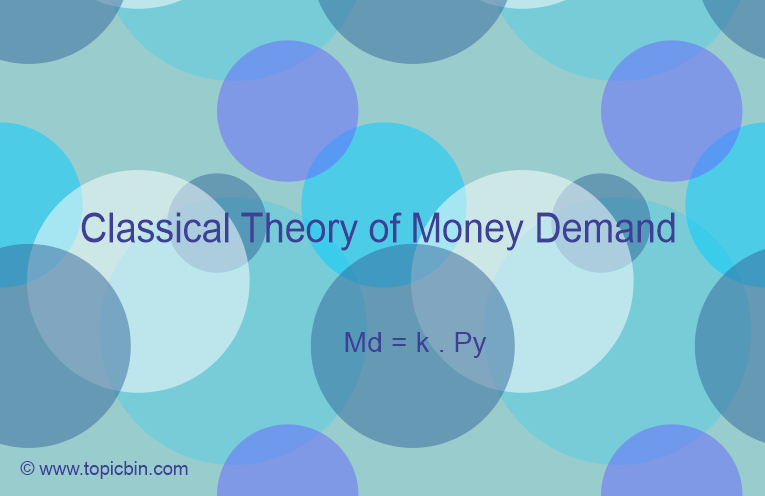The quantity theory of money is a classical theory of money demand; why? You will understand the concept of money demand, reasons to hold money, the classical theory of money demand, and its implications and criticism after reading this article. But before that, we advise you to read the full article about the quantity theory of money.
Concept of Money Demand
Although people do not hold idle cash balances, they hold some quantity of money for transaction purposes. In fact, the demand for money is the quantity of money that people want to hold. However, in a wider sense, the demand for money is the monetary assets that consist of cash balances along with checking accounts that people want to hold in their portfolios.
Why do people hold money? The reason is that they want to settle financial transactions. In the classical sense, people want to hold money only for transaction purposes. That means demand for money does not depend on interest rate; it depends only on the volume of transactions. This way, money only works as a medium of exchange, not as a store of value, from the classical viewpoint. To sum up, the more transactions to settle, the more money people want to hold.
Classical Theory of Money Demand
The classical theory of money demand refers to the quantity theory of money. Now, let us start with the familiar equation of exchange, MV = Py. We take this equation of exchange as given from the quantity theory of money.
The quantity theory of money links the total money supply (M) to the total spending on goods and services (Py) in the economy. The velocity of money, V, is the concept that works as the link between total money supply and total spending.
Let’s rewrite equation of exchange dividing on both sides by V as,
M = 1/V . Py …… (i)
Note that ‘M’ on the left-hand side of equation (i) represents the total money supply in an economy. In addition, when the money market is in equilibrium, money supply (M) equals money demand (Md) i.e.
M = Md ….. (ii)
Now, considering money market equilibrium, we can derive the money demand function by replacing M with Md in equation (i) as Md = 1/V (Py). Since V is assumed to be constant (why? You will see later.), we can replace 1/V with some constant k as
Md = k . Py ….. (iii)
The equation (iii) is the money demand function, another way of interpreting Fisher’s equation of exchange. The equation tells us that a certain portion of nominal spending (Py) is the money people want to hold (Md). This is why the quantity theory of money is the theory of money demand.

Classical Money Demand Function in Real Terms
Dividing on both sides by P the equation (iii), we get the real money demand function as,
Md/P = k. y ….. (iv) .
Equation (iv) tells us about the real money balance. The money balance in terms of goods and services that people want to hold is proportional to real income.
Why Constant Velocity (V)?
In the equation of exchange MV = Py, a fall in V could offset a rise in M, leaving MV and Py unchanged. Here, the question arises about the stability of velocity: Is V stable?
Advances in institutional (spending habits) and technological features (payment technology advances) may reduce the need for holding a money balance. For example, increasing the usage of bank cards and online payment systems is likely to reduce the demand for money relative to income. Similarly, the public’s spending habits may significantly change to cause the velocity of money.
However, Fisher’s assumption is that institutional and technological features change very gradually over time. Thus, the velocity of money remains fairly constant over a long period.
The constant velocity refers to the stable money demand function, which is a prerequisite for effective monetary management. Depending upon the stability of money demand, the central monetary authority targets either the money supply or the interest rate. If money demand is stable, the target will definitely be the money supply. That means tuning the money supply is to tune price and income.
Implications of Classical Theory of Money Demand
The quantity of money that the people want to hold is proportional to nominal income. That means the demand for money is determined by the level of income.
The constant velocity of money implies a stable money demand function, which is the prerequisite for effective monetary policy to manage the quantity of money. If the money demand function is stable (V is constant), then the central bank should target the money supply instead of the interest rate.
According to the quantity theory of money, the quantity of money has a directly proportional relationship to the price level. This means the quantity of money is fully reflected in the price level. Thus, there is neutrality of money. In other terms, the quantity of money has an effect on the real variable y of the right side of equation (iv).
Criticism of Classical Theory of Money Demand
J. M. Keynes has proposed a different approach to the demand for money, also called liquidity preference theory. According to him, demand for money is elastic; a higher interest rate leads to a lower demand for money due to the opportunity cost of holding money, which earns virtually no interest on Keynesian analysis.
Therefore, changes in the interest rate cause the velocity of money to change. That means the classical assumption of the constant velocity of money no longer holds in the Keynesian theory of money demand.